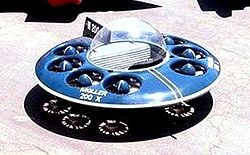Circular wing aircraft
Nemeth Umbrella Plane
In 1934, at Miami University (of Ohio), an aircraft called the Nemeth Umbrella Plane (aka Roundwing) was tested. (Nemeth is sometimes spelled Nuneth.) This aircraft had a parasol wing of circular form above a conventional fuselage and tail, and it was powered by propeller in a tractor configuration. [2] [3]
Sack AS.6
During World War II, a number of disc-shaped aircraft were proposed by aircraft designers in Germany. One of the few to make it further than the drawing board was the Sack AS-6, an experimental light plane with a round-winged planform that first flew in 1944. The aircraft proved unsuccessful, and was scrapped in early 1945. [4]
Vought Flying Flapjack
During WWII, Charles H. Zimmerman led a team at Chance-Vought that created a series of designs that eventually resulted in the Vought Flying Flapjack, [5] one of the first aircraft explicitly designed as a disc for aerodynamic reasons. The Flapjack had a large wing and very low wing loading, allowing it to take off easily from aircraft carriers. As with the earlier Vought V-173, the Flapjack's counter-rotating propellers were located at the ends of the wings to help counteract the drag-inducing vortices that would normally result from a wing of such a low aspect ratio. By the time the design was flying in the post-war era, jet engines had rendered the design obsolete and the US Navy lost interest.

In 1943, Boeing Aircraft built 3 scale model aircraft whose designs had saucer-shaped wings with a propeller in the front, and a rudder in the back. The cockpit was to be in front of the wings. There was no actual fuselage in the center. The aircraft model numbers were 390, 391, and 396. They were to be powered by a Pratt & Whitney R-4360-3 Wasp Major radial engine and capable of reaching speeds of 414 mph. They were intended to be fighter planes, armed with 4 20mm cannons and underwing hardpoints that could carry 1,134 kg (2,500 lb) bombs or external fuel tanks. Boeing submitted the proposals to the US Navy. The wing design had excellent short takeoff and landing (STOL) characteristics,[ citation needed ] that is preferred for fixed-wing aircraft carrier planes. The Navy rejected the Boeing designs in favor of the similar-shaped Chance-Vought V-173/XF5U-1 aircraft. [5] [6]

